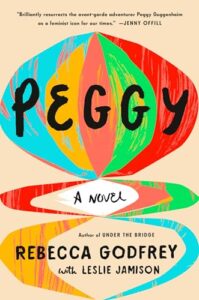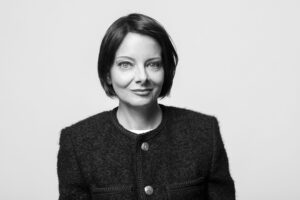‘Spoiled, spectacularly self-absorbed, and absurdly rich’
Peggy
by Rebecca Godfrey with Leslie Jamison
Toronto: Knopf Canada, 2024
$36.00 / 97803458082
Reviewed by Candace Fertile
*

Rebecca Godfrey, a Victoria-raised New Yorker who died in 2022, was probably best known in BC for her true-crime story Under the Bridge, about the murder of teenager Reena Virk in Victoria by other teenagers.
Peggy is a novel about the extremely wealthy Peggy Guggenheim (1898-1979) and was finished by Leslie Jamison who worked from hundreds of manuscript pages and notes, along with help from Godfrey’s friends. To be a writer and then to try to take on and complete the vision of another writer must be a daunting task.
The three parts of the book are titled Old Master, Surrealism, and Modernism, which indicate Guggenheim’s lifelong love of and interest in art. Unfortunately, much of Guggenheim remains out of sight, perhaps because she seems to be endlessly striving to present herself as a character, someone breaking through restrictions and being contrary. The novel is from Guggenheim’s point of view, and the constant posturing becomes tiresome. She wants to free herself from her controlled life, in much the same way as her father did by running off to Paris, abandoning his wife and three daughters. But they did not suffer materially. With her inherited wealth, Guggenheim devoted much time and money to supporting artists and writers and to buying art.
But against all the beauty and excitement that art gave her life, Guggenheim suffered through a complicated personal life. She was rebellious as a child, missed her father, was estranged from her younger sister Hazel (who may have killed her two sons), and was devastated by the death of her sister Benita. Guggenheim suffered a dismal marriage to a truly awful man and stayed with him long after she should have left, it appears, and had to give up her son to her ex-husband. The outlines of her life are easily found.

The novel attempts to get inside the head of a potentially fascinating character and view the world from her perspective. And while Guggenheim is aware of her immense privilege, the world she inhabits is so different from most people’s that it’s hard to comprehend. For example, she says, “I was born on Park Avenue. 1898. We lived in a strange and lavish mansion. My father filled the home with his whims and treasures: a bald eagle he’d shot; a Corot, a Watteau, caged slippers from Morocco. There was a glass dome that let in the stars, an immense stairwell, a separate floor for his daughters, an elevator that terrified us all.”
As an adult, Guggenheim has affairs with many men, including Samuel Beckett, but she doesn’t seem to have real friends. She talks about how much she loves Benita, but it’s not really seen. In a way, Guggenheim tells much more than she shows, and creates distance. Basically, she doesn’t sound like a very nice person. But this book is a novel, so who knows what she was really like?
The writers are adept at describing the homes and furnishings of the Guggenheims; the clothing and cars; the locations in New York, Paris, and the south of France. The ending of the novel moves quickly. A later chapter, “Bird in Space: 1938,” begins with Guggenheim writing a letter and saying, “I am in Paris working hard for my gallery [in London] and fucking.” She details her affair with Beckett, and the chapter ends with the hugely successful gallery opening on January 24. But war is on the horizon.
The novel then jumps to “Epilogue: 1958,” when Guggenheim has established herself and her gallery in Venice, one of the key tourist attractions in that city today. She remarks, “Twenty years ago, as the Germans got closer and closer [to Paris] all I could think about was collecting as much beauty as I could. A painting every day, I said. . . . ” Her collection needs to be transported to the US for safety, and she notes, we “made sure my Jewish name was nowhere on the shipping crates.” Being Jewish was always an issue for the Guggenheims, and as a child, Peggy was well aware of discrimination.
Ultimately, Peggy raises more questions than it answers. Being inside the head of a spoiled, spectacularly self-absorbed, and absurdly rich person who always seems just out of reach as she moves around the world fulfilling her desires is not as much fun as I thought it would be.
*

Candace Fertile has a PhD in English literature from the University of Alberta. She teaches English at Camosun College in Victoria, writes book reviews for several Canadian publications, and is on the editorial board of Room Magazine. [Editor’s note: Candace Fertile has reviewed books by Ian and Will Ferguson, Shashi Bhat, Carleigh Baker, Kathryn Mockler, Lucia Frangione, Darcy Friesen Hossack, Robin Yeatman, Emi Sasagawa, Patti Flather, Peter Chapman, Janie Chang, Pauline Holdstock, Ava Bellows, Beth Kope, Geoff Inverarity, and Angélique Lalonde for BCR.]
*
The British Columbia Review
Interim Editors, 2023-25: Trevor Marc Hughes (non-fiction), Brett Josef Grubisic (fiction)
Publisher: Richard Mackie
Formerly The Ormsby Review, The British Columbia Review is an online book review and journal service for BC writers and readers. The Advisory Board now consists of Jean Barman, Wade Davis, Robin Fisher, Barry Gough, Hugh Johnston, Kathy Mezei, Patricia Roy, Maria Tippett, and Graeme Wynn. Provincial Government Patron (since September 2018): Creative BC. Honorary Patron: Yosef Wosk. Scholarly Patron: SFU Graduate Liberal Studies. The British Columbia Review was founded in 2016 by Richard Mackie and Alan Twigg.
“Only connect.” – E.M. Forster